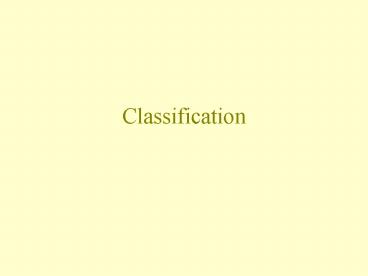Classification - PowerPoint PPT Presentation
1 / 27
Title:
Classification
Description:
Similarities (dissimilarities, resemblance functions) based on qualitative ... Jacquard. d - number of species absent from both samples (usually not used) ... – PowerPoint PPT presentation
Number of Views:22
Avg rating:3.0/5.0
Title: Classification
1
Classification
2
Similarity measures
Each ordination or classification method is based
(explicitely or implicitely) on some similarity
measure
(Two possible formulations of ordination problem)
3
Similarities (dissimilarities, resemblance
functions) based on qualitative/quantitative data
Other indices used for sample similarity and for
species similarity
Similarity of two samples has a meaning by
itself similarity of two species has meaning
only in relation to the data set. Species set is
fixed, samples are random selection from a
population
4
Sample similarity based on qualitative data
Sörensen
Jacquard
d - number of species absent from both samples
(usually not used)
5
Species similarity based on presence absence
d - number of quadrats without both species -
absolutely necessary
6
Quantitative data
Transformation is an algebraic function
Xijf(Xij) which is applied independently of the
other values. Standardization is done either with
respect to the values of other species in the
sample (standardization by samples) or with
respect to the values of the species in other
samples (standardization by species).
Centering means the subtraction of a mean so that
the resulting variable (species) or sample has
a mean of zero. Standardization usually means
division of each value by the sample (species)
norm or by the total of all the values in a
sample (species).
7
(No Transcript)
8
Euclidean distance
For ED, standardize by sample norm, not by total
The samples with t contain values standardized by
the total, those with n samples standardized by
sample norm. For samples standardized by total,
ED12 1.41 (v2), whereas ED340.82, whereas for
samples standardized by sample norm,
ED12ED341.41
9
Percentual similarity (quantitative Sörensen)
10
Similarity of species based on quantitative
data Correlation coefficients (ordinary, rank)
11
Similarity of samples vs. similarity of
communities
12
Normalized expected shared species
expected number of shared species in two
subsamples taken randomly from the second sample.
2
2
13
Similarity matrices - directly used
in Multidimensional scaling (both metric and
non-metric) Mantel test
14
(No Transcript)
15
(No Transcript)
16
Classification
17
Hierarchical agglomerative (cluster analysis)
18
Subjective decissions in the objective procedure
19
Single linkage and complete linkage
20
Single linkage - gt chaining
21
Order does not play a role
22
TWINSPAN (Two Way INdicator SPecies ANalysis)
Pseudospecies
23
01 is more similar to 1 than 00
24
(No Transcript)
25
(No Transcript)
26
(No Transcript)
27
(No Transcript)































